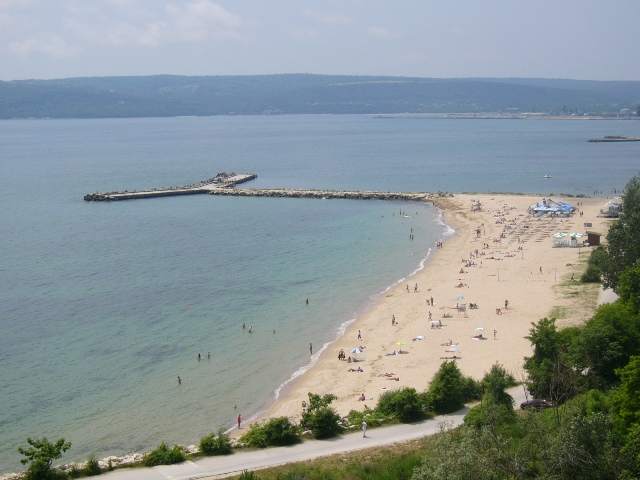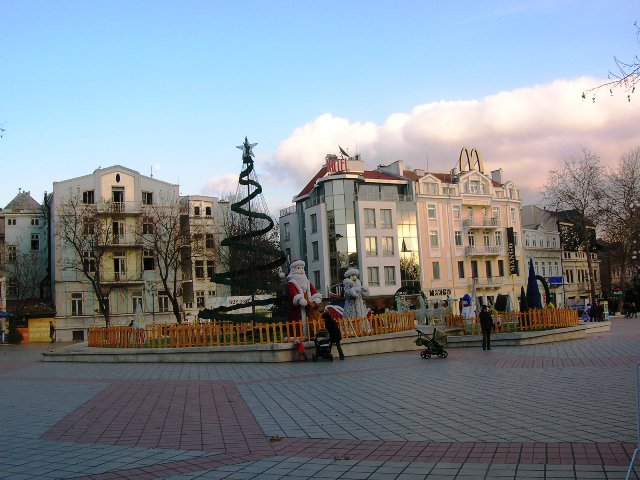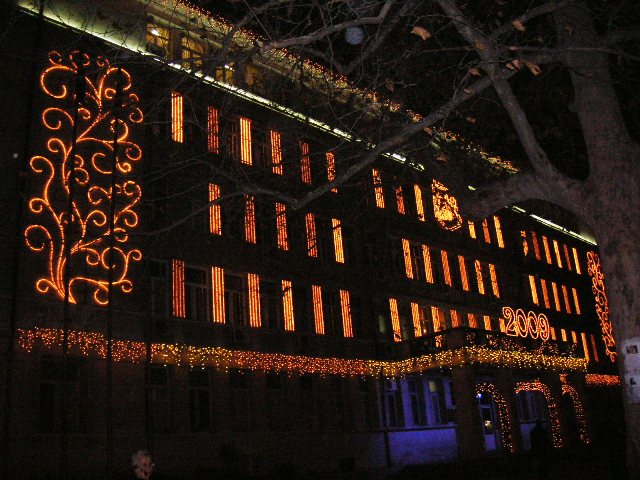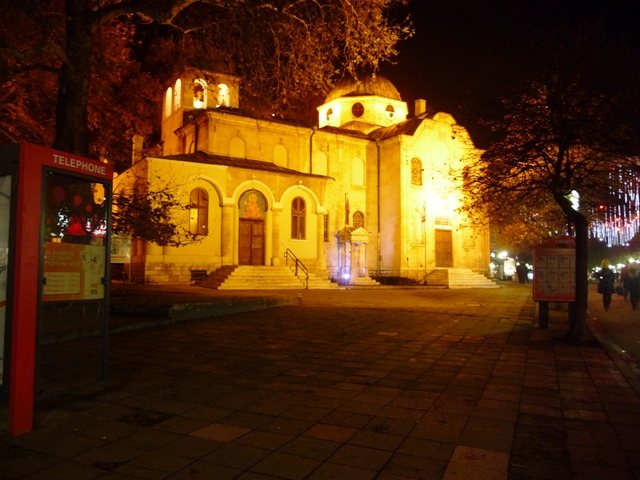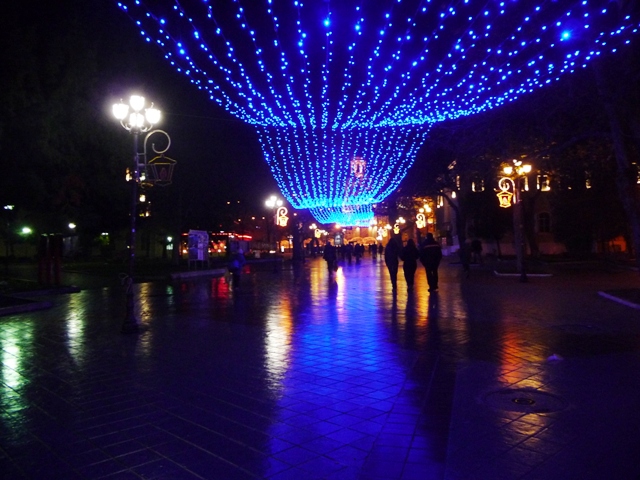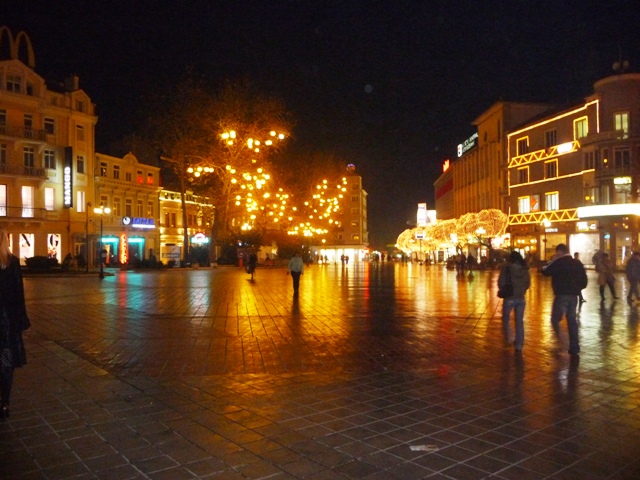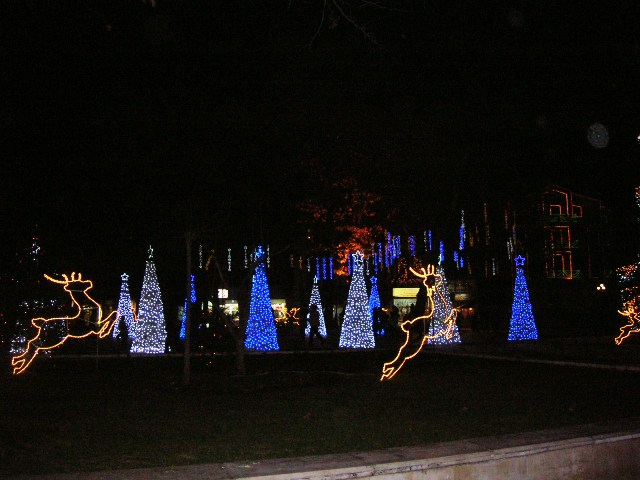VARNA
Varna Featured in a Financial Times Article
The city of Varna (population 314 539) is situated at the Bay of Varna, 470 km east of Sofia.
Varna is the biggest city at the Bulgarian Black Sea coast and was once again named The Best City to Live in in Bulgaria in 2008. It is situated at the same latitude with Cannes, Nice, Monaco and Livorno. It is nestled in the deep valley between the Frengen Plateau and the Avren Plateau, where two lakes were formed during the polyotsen - the Beloslav Lake is to the west of the city and the other - Varna Lake is within the limits of the city itself. Varna is a city over 11 km long, its width, including the new residential quarters is nearly 9 km. The city is like an amphitheater and follows the curves of the Bay of Varna.
It is surrounded by lots of gardens, vineyards and deciduous groves. Almost the whole territory is occupied with private country-houses and their small farms. The city is a regional administrative centre.
HISTORY
Varna has a history that could be traced back for thousand years. Due to its favourable location and visibility of almost 270 degrees the small cape, which now hosts the sea station, was inhabited by an ancient Thracian tribe - Corbisy in their small fishermen's settlement. In 6th century BC a Greek polis (settlement) inhabited by colonists and settlers from Millet emerged here under the name of Odessos.
The town became a fishing and farming colony and later on in the 5th century BC it turned into a real centre of commerce. Up to the Roman domination the Thracian god Darzalas was worshiped rather than the common gods Apollo and Dionyssus. Old Greek and Roman sources evidence that in Darzalas' honour processions, mysteries, games and competitions were organized. The town had been under the siege of the troops of Alexander of Macedonia in the middle of the 4th century BC but after the siege was put down the town was given autonomy within the limits of his Empire. After the uprising and its liberation during the rule of Lisimah the town re-established its supremacy at the north Black Sea coast.
Up to the 1st century BC it was an independent polis and minted coins with the effigy of its patron god. Conquered by Mark Lukulus' legions, it became a Roman regional centre of great importance. There the great epic poet of Rome Ovidii stayed in his way to the town of Tommy (nowadays Kyustendzha, Romania) where he was sent on exile. Gradually Odessos lost its supremacy in the region, which was then gained by the town of Martsianopolis (nowadays Devnya) founded by the Emperor Trayan. Being conquered and devastated several times during the barbarian invasions it was for some time within the Byzantine Empire then out of its territories. In 9th century it was already called Varna.
It is supposed that the name originates from the horse people in Central Asia-toponymy (name of an area) and hydronymy (name of a water basin) in India (the river that runs into the Ganges at Varanassi) and from the concept of caste (colour). After the numerous wars between Bulgaria and Byzantine, the town was included in the territory of Bulgaria in the beginning of the 13th century during the reign of King Kaloyan. Its defence system consisted of three strongholds: one - at the Cape Galata; other - at Cape St. Dimitar and the third, called Petrich was near the lake of Beloslav. Despite its reliable defense system, the town was conquered by the Turks in 1391 and it soon declined.
In 1444, during the crusade of the Polish king Vladislav Yagello (Varnenchik) and the Hungarian leader Yanosh Huniady, the town was under the siege of the knights. Despite the fact that the troops of the Christian coalition fought bravely they suffered a complete defeat. The young king Vladislav was killed. The citizens of Varna built a mausoleum in his honour. In the course of time the town more and more acquired an Oriental outlook. Many Turks settled there. Mosques, konaks (town-halls) and Turkish baths were built. The construction of churches was strongly forbidden for a long time. Varna became a mighty stronghold, which guarded the north-east borders of the Ottoman Empire and a commercial and craftsmen' centre of great importance.
During the Russian-Turkish War in 1828 the town was conquered by the Russian troops and hold under their rule for some time. An uplift of the national spirit began in the next decades. Schools, community centres and churches were built. In 1878 Varna was finally liberated from Ottoman rule and became the most important Bulgarian seaport town. At the end of the 19th century it was connected with Sofia by railway. Many factories were opened, and industrial fishing was developing. Varna quickly established as a seaside resort as well, enhanced by the European fashion in architecture and water transport. Entertainment establishments and holiday houses were built. Varna won the fame of a favourite place for Bulgarian cultural elite. For a short time the city was renamed Stalin. After 1956 its previous name was reinstated. Varna became a centre of the North Black Sea coast and a starting point for the design and building of the numerous resorts around it. Marine business developed - from fishing to the transfer of goods between the East and the West. Nowadays Varna is an industrial city - the third biggest one in Bulgaria after Sofia and Plovdiv. Landmarks. The Roman Spa are situated in the centre of the city. They were built in the 2nd century during the reign of the emperor Antony Pii and were abandoned in the 5th century during the barbarian invasion. After much research and restoration they are now preserved and are frequently visited by tourists and guests of the city. Pottery workshops were opened in the 14th century, and later on a small residential quarter was built. The Roman Bath dates back to the 3rd century. It is built on layers of stones and bricks, bound by a mixture of plaster and crumbled tiles and bricks. The walls are grouted with water resistant plaster, there are marble tiles on the floor and some of the premises were panelled in marble. In the 5th century the building was considerably extended and reconstructed due to the development of that part of the city. Nowadays it is a sight of tourist and archaeological interest.
The Holy Virgin Cathedral is considered to be an emblem of the seaside capital of Bulgaria. It rises at the very city centre across from the theatre alley. Buses start from the square in front of it to all the vicinities and to the airport. A Revival master in the manner of Petersburg architecture built the church in 1866. Not until 1910 was it sanctified because its building and icon painting took a lot of time. The woodcarving of the altar and the Episcopal stall are made by masters from the Debur school, Macedonia. The central wall paintings were completed in 1950.
The St. Nikola Church is located near the Sea Garden Park and dates back to the 1866. It has very interesting wall paintings and ancient icons by masters, belonging to various icon- painting schools in Bulgaria.
The Sea Garden Park is another emblem of Varna. It dates from the end of the 19th century, being finally completed in 1908. At that time the idea to place the busts of outstanding Revival figures in some of its valleys was accepted. Nowadays there is an amphitheater; astronomic site, the first in the country, with an observatory, planetarium and a tower; many playgrounds for children, and a small channel, where they can practice rowing, as well as a pool for water wheels and a zoo. The open-air theatre is a place, where various activities take place. These include the Varna Days of Music, the world famous International Ballet Competition and Varna Summer - a trienalle of arts.
The central sea baths and the beach are located beneath the Sea Garden Park. They were built in the beginning of the century and are equipped with a polyclinic, water- and mud-cure complex, two quays, several restaurants and disco clubs.
The Russian Monument is in Primorski Park. It was erected in honour to the Russian soldiers who died in Varna in the War of Liberation. The Asparouh Bridge connects the city centre with the residential quarterss Asparouhovo and Galata. It is the longest bridge in Bulgaria and works on it are still under way. Here the local club for extreme sports organises Bungee jumps. To the east of the bridge the Bay of Varna and the Cape Galata could be seen. To the west is the Varna Lake.
The Clock Tower was built in 1880 and it rises across the cathedral. Beneath the cathedral is one of the branches of the Theatre of Drama and the Club of the culture activists.
The Festival Complex is opposite the entrance of the Sea Garden Park. It is a modern building of aluminum, stone and glass. It has several stages, conference-halls, a big bazaar, and a sweet shop. Many exhibitions and festivals are held here as well as ballet and theatrical performances.
The Sports Palace is located at the motorway to the resorts Golden Sands, St. Constantine and Albena. Competitions in over 30 sports games take place there; exhibitions are held; concerts and performances take place, too. The design of the palace is actual copy of the Palace of Culture in Lagos, Nigeria, built by Bulgarian experts.
The Dolphinarium (Show-House) is one of the favourite attractions for children and guests of Varna. There are regular performances and demonstrations with the clever dolphins. Feeding the dolphins and taking pictures is allowed. Each year new stunts are performed here and the show gets more attractive, including performances by mime artists, clowns and actors.
The Theatre of Drama is in the city centre. It was built nearly a century ago after the fashion of Vienna. It houses a theatre, an opera and philharmonic halls. Its foundations were laid by actors in the French Army during the Crimean War in 1856. The first Bulgarian theatre performance of Bulgarian drama was performed here. Not far away is the Puppet Theatre, where the Golden Dolphin Festival of puppets takes place each year.
MUSEUMS
The Archaeological Museum is housed in a building that used to be a school during the Revival. Here visitors can see miniature models of pile dwellings from the Palaeolithic period; the hall to ancient arts and means of living; the hall to antique arts one of the biggest and most impressive collections in the country; some objects and church plate from the early ages of Christianity; objects of cult from the ancient Bulgarian ethnicity; the hall with exponents from the 13th-14th century, where the development of crafts at that time could be traced; the hall of Bulgarians applied arts and a lapidarium, where sarcophagi, tombstones, steels and tomb columns are displayed. The museum holds some rare objects from Egypt, Greece, Babylon and the Mediterranean countries, which were transported to ancient Odessos via the trade routes.
The Museum of National Revival is housed in a building from 1861, which was proclaimed a cultural monument. Patriotic citizens and scholars arranged the museum exhibition in 1959 and it has been enriched and extended many times. The original arrangement of St. Archangel Mihail Church can be seen on the ground floor. An impressive exhibition shows the struggle for religious enlightenment, national independence and the epic battles during the Russian-Turkish War of Liberation.
The Naval Museum is in the Sea Garden Park and possesses all the important documents and equipment of Bulgarian Navy from its foundation in 1878 up to the present. The great scientist Karel Shkorpil founded it in 1923. There are cannons, old anchors, and sea vessels and so on in the yard of the museum. T
he Vladislav Varnenchik Park-Museum is to the north-east of the city, near the crossroads for Sofia and Dobrich. It was built in honour of the historical battle in 1444 when Czechs, Poles, Croatians, Hungarians and Bulgarians tried to resist the Turkish invasion in Europe. A mausoleum to Vladislav Varnenchik was built in 1934 on the foundations of an ancient Thracian tomb.
The Ethnographic Museum is housed in a Revival house from the 19th century. A typical arrangement of the house of Varna in that time is shown. Many kinds of jewellery are displayed, as well as clothing, formal national costumes, everyday life items and goods manufactured goods in the city and its vicinities.
The Museum of Nature and Science was founded in 1960 and it displays species typical of the Bulgarian flora and fauna. Geological and speleological miniature models show the stages of the formation of the lithosphere. There is a small board with the main kinds of stones and minerals. The exponents are displayed in three specialised halls - geology, flora and fauna.
The Aquarium and the Black Sea Museum were opened in 1932 - the first and the only marine biological station in the country. In 1954 the Scientific Research Institute on searelated issues, fishing and industrial fishing was opened with the Aquarium. Hundreds of fish species are gathered here: molluscs, actinides, crabs, periwinkles as well as species of the fresh water rivers. A special place is occupied by the natural resources derived from the Black Sea, such as sea salt and oil.
The Museum of Medicine is the only one on the Balkan Peninsula. Medicinal plants and herbs are here on display, as well as surgical and other medical tools and clothing used in ancient times up till now. It was founded in 1869 as a private hospital with a small museum.
The Museum of Art and History of Varna has an exceptionally rich collection, one of its exhibits being the Gold Treasure of Varna - dating back 6000 years ago it is the oldest processed gold found in the world. 281 tombs were found in a necropolis dating back to the Halcolith Age. One of them contained more than 3000 golden articles (statehood attributes, jewellery, adorning, etc.), of the total 6 kg weight.
The Art Gallery was opened in 1950. It possesses paintings by the most outstanding Bulgarian artists as well as pieces of work by numerous foreign artists, donated to the gallery by private persons.
A branch of the museum is the Georgi Veltchev Museum-House, where canvases by the prominent artist of Varna are displayed. An exhibition of icon-paintings from the Revival is arranged in the St. Atanas Church, built in the 13th century near the Roman spa. The church itself is very original with its mural paintings and icons and with its carved altar and bishop's throne. There is a collection of wood-cuts, etchings, liturgical and canon books from Bulgarian Revival.
Varna's festivals are large in number, the most popular of them being: the International Choir Gathering - at the end of May, International Theatre Holidays - a part of Varna Summer Festival - in June; part of the aforementioned festival is also the International Gathering of Orchestras and Classical Music Ensambles - in July; again as part of the festival is the Jam Session in July and August. Other important cultural events are: the Folk Festival with international participants - in August; the International Ballet Competition in August; the Love is Folly Cinema International Festival - in September; the Golden Rose Festival of Bulgarian Cinematography; The Gold Dolphin International Festival of Puppet Theatres, held every year in October.
ACCOMMODATION
For hotel reservations in Varna, please visit www.VarnaHotels.com
CATERING
Varna's most popular luxurious and offering special cuisine restaurants are: the Indian Maharany Restaurant, Maggy Restaurant and the Moussala Restaurant with a Viennese Cafe, the Paraklisa Restaurant, the FEB Restaurant, the Morska Sirena Restaurant, a chain of restaurants Mustang Food Bar, Happy Bar and Grill chain, Loza Restaurant, Morsko Konche Restaurant, and the Galateya Restaurant.
Middle class restaurants, numerous private pubs and taverns are available even in the distant residential quarters of the city. Many of them are open 24 hours, others - as long as there are clients to be serviced. For those who prefer cooking for themselves there is a large chain of supermarkets with non-stop or regular working hours. There are a lot of market places as well. The most popular one is called Kolhoz. A lot of small pizza shops and snackbars that offer typically Bulgarian snacks such as sheeted pastries, cheese buns, dough nuts, boza (soft drink made of millet), and others. There are a great number of canteens, especially along the beach and in the Sea Garden Park where fish and seafood are offered. Every day one can buy freshly caught fish from the local fishermen at the sea station.
CINEMAS AND THEATERS
There are about ten cinemas functioning in Varna. Some of the best are in the city centre.
Stoyan Buchvarov Theatre of Drama is open during the whole holiday season with its three stages. Varna Opera and Philharmonic Orchestra also have their performances. The Puppet Theatre is also open throughout the season. As a rule, the theatres are on holiday during the summer, but in the beginning and at the end of the summer one can see many performances from all over the world at the Theatre and the Puppet Theatre Festivals, respectively. Good foreign theatrical companies are not an unusual event for the city. They perform attractive non-verbal shows, delivered for foreign guests, especially. In the open-air theatre pop and folk stars often have concerts, shows and ballet performances also take place there.
TRANSPORT
The fastest way to get to Varna is by airplane, it takes 50 min from Sofia to Varna. Varna Airport functions throughout the year. Planes in both directions fly 6 or 7 times a day during the summer.
The airport phone number is +359 52 573323
The Balkan Ticket Office answers phone number +359 52 222248.
The sea station provides sea buses to Balchik, Slunchev Bryag (Sunny Beach), Nessebar and Burgas.
The railway station phone number is +359 52 630414.
The phone number of the booking office is +359 52 632347.
Varna is connected to all of the main railway lines in the country. There are express trains to Sofia and Plovdiv that reach for 7 and 4.30 hours respectively. Seats are limited so it is advisable to book sleeping car tickets a week before.
The bus station is 1.5 km away from the city centre.
Its phone number is +359 52 448349.
Buses for all the main destinations in the country start including Sofia from here.
The Group Private Bus Company offers bus lines to all destinations (tel.: +359 52 256734).
Buses travel to Athens and Istanbul as well as to some cities in Central and Eastern Europe. Their bus stop is in front of the cathedral.
Varna's public transport offers over 60 bus lines that travel to various destinations. Some of the buses travel to the nearby resorts (20 km away from the city). There are trolley buses available in the city as well.
INDUSTRY AND TRADE
Varna is the third biggest industrial center in the country with busy shipping, shipbuilding and ship-repair activities. A significant part of the electronic, glass, china and faience industry, tailoring and shoe industry is concentrated in Varna district.
The city provides excellent industrial infrastructure. Sensing the industrial potential of the area, many national and foreign companies have invested in the ongoing industrial projects.
The hotel industry, agriculture, forestry and fishing are other important Varna industries. Major trades in Varna include service and repairing of bikes and other motor vehicles.
SURROUNDING AREAS
The famous village of Vinitsa is situated 10 km north-east of Varna, where the so called Gagaouzi people live - they are Christians who speak Turkish and have very interesting customs and traditions. It is a favourite place where the citizens of Varna often go on picnics or for walks, it is also visited by a lot of tourists. The Cape Galata is very attractive to a lot of tourists who seek solitude among nature. It is situated in the distant part of the Galata Quarter. There are wide meadows among deciduous groves and natural water springs with drinking water, and rocks convenient for fishing and cockle catching.
The Romantika Resort includes several hotels (tel.: +359 52 226317). It offers sports facilities for all kinds of water sports, cruises and voyages by the local water transport. Around the Asparuh Bridge near the quarter of the same name the relics of the rampart of Asparuh can be seen. The great Bulgarian ruler built them 13 centuries ago in order to resist the raids of the Byzantine fleet. To the south of the lake of Varna the Dzhanavar Hill can be visited. A basilica from the early Christian period is built here. In the 6th century there were fortifications to resist the raids of the Avari tribe.
The Pobitite Kamuni (Rammed Stones) are 18 km west of the city. They were formed by erosion about 50 million years ago. Dead cockles, sea species, and fossils are constituents of these stones, and of the sands around. Some of the stones have zoomorphic and anthropomorphic profiles. Many of them were place of worship or consecrated grounds during Thracian, Slavonic, and ancient Bulgarian times. Now they are an interesting tourist sight and a place where a lot of historic and adventure films have been made. The town of Devnya is connected by the Varna Canal with the Varna Lake. It is famous for the industrial production of soda. There are remains of the ancient town of Marcianopolis, the second biggest town in ancient Bulgaria after Philipopolis. It was a stronghold against the numerous raids of the tribe of Dacians against the Emperor Trayan. In 3rd century it was so big that it was difficult to see it even from a bird's eye. The foundations of the defence walls, the rampart, the turrets, and the town's forum are in good condition. There are remains of other buildings as well. The Petrich Kale rises opposite the railway station of Razdelna on Varna-Sofia railway line. The fortress was built in 5th century, later on it was destroyed down and rebuilt in 13th - 14th centuries. It was an important defence fortress in 1444 during the battles of Vladislav Varnenchik. The rocks near the fortress are perfect for mountaineering.
View Properties for sale in Varna
Search for Related Articles in Our Article Section
Read the article about Varna published in Financial Times
Request more information
Whether you’re dreaming of a peaceful countryside escape or a charming village house to restore, we have great-value options — many under £10,000. Our team will guide you through the entire buying process and support you even after the deal is done.
Start your new chapter in Bulgaria with confidence and local expertise by your side!


